Editor’s note: Darren Hartwell played wide receiver at Williams College and was invited to Harvard University’s 2013 Pro Day, where he participated in the same drills that players run at the NFL Scouting Combine. He’s a writer now, so you probably can guess how that went.
A lot goes on behind the scenes when teams evaluate NFL prospects. But what’s the fun in discussing that?
The 2016 NFL Scouting Combine officially began Wednesday, when the first crop of draft prospects sat down for media interviews. The real fun begins Friday, though, when running backs, offensive linemen and special-teamers hit the field at Lucas Oil Stadium in Indianapolis for on-field workouts. Quarterbacks, wide receivers and tight ends will follow Saturday, defensive linemen and linebackers will work out Sunday, and defensive backs will close things out Monday.
For draft prospects looking to catch scouts’ eye, the combine is their chance to make a splash. They’ll be tested in six drills: 40-yard dash, bench press, vertical jump, broad jump, three-cone drill and shuttle run. The 40-yard dash usually garners the headlines, but all six play an essential role in an athlete’s evaluation.
So what are the basics to each drill and the secrets to success that separate surefire first-rounders from NFL wannabes? Glad you asked.
40-YARD DASH
Description: This one’s pretty straightforward: Start in a 3-point stance and sprint as fast as you can for 40 yards. Split times are measured at the 10-, 20- and 40-yard intervals.
Key to success: The start. Plenty of college athletes have elite top speed, but an explosive start can be the split-second difference between a good 40 time and a great one. Look for the athletes with the fastest 10-yard splits to garner the most attention from scouts and viewers alike.
2015 standouts: WR J.J. Nelson (4.28 seconds), CB Trae Waynes (4.31 seconds), RB Jeremy Langford (4.42 seconds)
BENCH PRESS
Description: The bench press is the purest measurement of upper-body strength. Do as many repetitions at 225 pounds — two 45-pound plates each loaded onto both sides of a 45-pound barbell — as possible before failure, and that number is your score.
Key to success: Proper form. The bench press is a test of endurance, so the more an athlete can keep his form consistent as his reps increase, the more he’ll impress scouts. An underrated aspect of bench press form is breathing — athletes are taught to inhale as they lower the bar to their chest and exhale as they push back up.
2015 standouts: OT Ereck Flowers (37 reps), LB Vic Beasley (35 reps), RB Joey Iosefa (30 reps)
VERTICAL JUMP
Description: This is a great test of explosiveness. Start by standing flat-footed with your right arm fully extended to measure your reach. Then, from a static position, jump as high as possible and hit a series of flags. The inch difference between your reach and the highest flag you hit is your result.
Key to success: Body control. Since the athlete has to physically touch a flag to register a score, there’s a temptation to wind up and give the flag a hard smack. But that often results in wasted body movement, and the most successful scores usually result when athletes limit horizontal movement and drive the majority of their energy upward.
2015 standouts: WR Chris Conley (45 inches), CB Byron Jones (44.5 inches), RB Ameer Abdullah (42.5 inches)
BROAD JUMP
Description: While the vertical jump measures upward explosion, the broad jump measures outward explosion. From a balanced two-point stance, jump as far forward as you can. Your jump is measured from the starting line to where your back heel lands.
Key to success: The hardest part of the broad jump is sticking the landing. If you stumble backward or lose your balance upon hitting the ground, your jump is disqualified, so there’s a tricky balance between trying to get the absolute most distance out of your leap and jumping just far enough where you know you’ll land firmly on two feet.
2015 standouts: CB Byron Jones (12 feet, 3 inches), WR Chris Conley (11 feet, 7 inches), LB Bud Dupree (11 feet, 6 inches)
THREE-CONE DRILL
Description: This drill tests your ability to change direction. Three cones are set up in an L-shape, each 5 yards apart. Run 5 yards straight ahead to Cone No. 2, run back to Cone No. 1, run around Cone No. 2 to weave around Cone No. 3 and finish back at Cone No. 1. Got all that?
Key to success: Attacking the angles. Just like a NASCAR driver finding the perfect line on a turn, the best athletes at the three-cone drill are those who can stay extra tight around the turns while not sacrificing any speed or explosiveness. This drill is a tricky one, and it takes a lot pre-combine practice to master the perfect run.
2015 standouts: CB Justin Coleman (6.61 seconds), WR Justin Hardy (6.63 seconds), LB Ben Heeney (6.68 seconds)
SHUTTLE RUN
Description: A simpler version of the three-cone that emphasizes lateral movement. Start in a three-point stance, run to touch a cone 5 yards to your right, runs to touch a cone 10 yards to the left of that cone and finish at your initial starting point.
Key to success: Nailing the transitions. As we mentioned with the 40-yard dash, top speed is easy to come by, but the ability to explode out of a stop is what will get you the fastest time. That places a huge emphasis on coming in and out of each transition with speed and control.
2015 standouts: CB Bobby McCain (3.82 seconds), RB Ameer Abdullah (3.95 seconds), QB Brett Hundley (3.98 seconds)
Thumbnail photo via Brian Spurlock/USA TODAY Sports Images
Videos produced by Andre Khatchaturian



